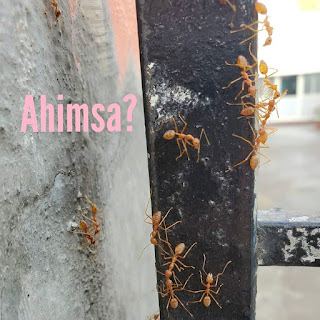Ahimsa - where is the limit?
Ahimsa - not hurting, in words, thoughts and actions. Does it apply to killing insects like ants and mosquitoes?
I practice Yamas since a few years. It is the first aspect of Yoga, before Asanas and all other limbs. I easily got used to eating vegetarian food, thinking positive and being nice. But I was recently doubting, if I can keep the practice up thoroughly. Where does it begin and even more important, where does it end?
I remember when I was working in Spain in my hosts garden, painting the outside wall of the house and the cables coming out of that wall. There was an ant pathway right there on that cable. I painted a part of the cable, then I saw the ants getting stuck in the fresh paint. I was shocked and organized myself a kitchen cloth to wipe away the ants before painting the next part. But ants kept on coming. And the wiping killed a few as well. They were faster than I could wipe and most of them still had to die.
It is easy not to hit or harass people around you. But when you try to sleep and suddenly you hear the buzzing sound of a mosquito next to your ear, what will you do? Will you try to kill it or catch it and set it free outside? Or just let it bite you?
How far does the practice of Ahimsa go?
We can try our best and hurt as less as possible. We can wipe away as many ants as possible or just don't paint walls and cables. We can catch mosquitoes and let them free outside or use a mosquito net. We can watch were we step and be mindful of other beings.
But with every meal (even vegetarian and vegan meals!) we still kill plants, insects, animals and microorganisms. Is it unavoidable? And with every breath and every step we kill billions of microorganisms. Can we avoid that?
The hard it is for me to accept - I realized that we can not avoid completely to kill or harm other beings if we want to stay alive.
So, there is a limit to Ahimsa. I would say, because we can not avoid hurting completely, we can do everything that we need to, to stay alive, BUT only as much as we really NEED to. The lesser we hurt, the better!
In this statement lies a link between Ahimsa and Aparigraha. Aparigraha is another one of the five Yamas, and it is a key element to the practice of Ahimsa. This principle is translated as "non hoarding". It means that you take only what you need and you don't accumulate things.
You eat only as much as you need, consume only as much as you need, breathe only as much as you need, move only as much as you need. If you follow it, you limit the damage you make in the world.
And another thing is attitude: When you eat, be thankful and have compassion with the life on your plate. When you consume, think of the lives that where involved to make this gift available for you. It makes you more mindful. Just live mindfully, grateful and compassionate. Then you practice the Yamas naturally.
I don't want you to feel guilty or sad that you had to kill other living beings, but just be grateful. Life is a privilege and you are the lucky one!




Comments
Post a Comment